Informatics, computer technology and management. Рубрика в журнале - Siberian Aerospace Journal
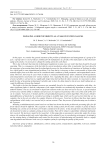
Managing a group of objects as a task of system analysis
Статья научная
In this paper, we consider the general statement of the problem of identification and management of a group of objects. A group refers to several objects combined for the manufacture of a product. The main feature is that when managing such systems, it is necessary to change the setting actions for each object. This is due to the fact that today the technological regulations in many cases are wider than they should be for good operating. This is a consequence of the fact that the current production culture (this, in particular, has been shown by the experience of processing data from the technological process for the production of transis-tors at Svetlana) is rather low, which leads to some organizational problems. It is clear that it is necessary to have certain models of objects that naturally differ from each other and can be considered under conditions of both parametric and nonparametric uncertainty. Moreover, there may be cases when an object is considered simultaneously under conditions of both parametric and nonparametric uncertainty over various channels. Now, regarding the delay, due to the fact that the measurement of some variables is carried out in a significantly long-er time interval than the object constant, it is necessary to distinguish the time of measuring technological vari-ables and, in fact, the delay typical to the process itself, taking into account the difference between the channels. This leads to the fact that dynamic processes are essentially forced to be considered as inertialess with delay. Another significant feature is that the components of the output variables are stochastically dependent in ad-vance in an unknown manner. The use of correlation or dispersion relations in this case does not lead to success. A special analysis of T-processes and the ability to simulate such processes are required. In particular, this is one of the tasks of this article. It contains: T-processes, T-models and the corresponding heterogeneous control algorithms. The process of hydrodeparaffinization of diesel fuel is considered according to available data, which can be said a priori that they are incomplete, that is they do not reflect the complex behavior of the pro-cess. From here it follows that these data require replenishment, which today is not carried out for various rea-sons. Thus, the process of hydrodewaxing can be taken to the T-process. Modeling a multidimensional system based on real data has shown that in this problem the presetting effect for different objects should be different. The exception is only the setting actions for the entire complex or group of objects. Modeling was carried out on the basis of T-models considered in the article. It has already been not-ed that these models should not be taken as complete, giving an idea of reality. They will be subject to algorith-mic refinement during further research. The decision is made by the researcher. At this stage that an assessment is given that, under the circumstances, the resulting models and control algorithms can be adopted for use in a production environment. An attempt to use the existing theory of identification and control for the process of hydrodewaxing will inevitably lead to a significant degradation and increase in the cost of a computer system for operating the quality of this process.
Бесплатно

Статья научная
One of the main characteristics of computer appliances for processing real-time information is reliability. The reliability of software is understood as the property of this software to perform specified functions, maintaining its characteristics within the established limits under certain operating conditions. Software reliability is determined by its reliability and recoverability. Reliability of software is a property to maintain its performance when using it for processing information in the information system. The reliability of the software is estimated by the probability of its operation without failures under certain environmental conditions during a given observation period. The development of real-time systems requires a large amount of resources for design and testing. One of the solutions to this problem is mathematical modeling of computer appliances. This allows more flexible design of real-time systems with the specified reliability, taking into account the limitations on price and development time, and also opens the possibility of more flexible optimization of computer appliances for real-time control systems. To develop a mathematical model of the reliability of computer appliance for real-time systems, it is necessary to take into account the provision of a given level of reliability, with reasonable development costs. There are many methods for improving software reliability, but the most promising and effective methods are redundancy, which is achieved using N-version programming. To increase the reliability of the hardware of the computer appliance, it is also necessary to use redundancy and redundancy, which includes multiprocessor and provision of different buses and independent RAM. This paper discusses existing approaches to improving the reliability of hardware and software, proposes a model of reliability of a computer appliance, which is understood as the product of the probability of failure-free operation of hardware and the probability of error-free operation of software. In addition, new formulas are proposed for the steady state probabilities of the hardware states of a multiprocessor computer appliance with heterogeneous processors, which give the same result as the existing ones, but require fewer computations. The paper concludes with a question about the possibility of optimizing the reliability of computer appliances based on the developed model, and indicates optimization methods that can be used to solve this problem.
Бесплатно
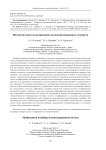
Mathematical modeling of autocompensation devices
Статья научная
The article studies the order of developing and describing mathematical models of automatic compensation devices of all-round radar stations. The development of algorithms for spatial processing of signals in radar systems with phased antenna arrays is an important stage in the design of radar stations. This article considers the procedure to create mathematical models of automatic compensation devices that differ in implementation methods, namely: the number of compensation channels, the position of the main and compensation (additional) channels of the radar station (stationary or dynamic), the amplitude-phase distribution of the main and additional antennas, the representation phased antenna array, algorithms for finding the weight vector. The method of computational experiment verifies the adequacy of the operation of the models and the results are comparable with the implemented automatic compensation devices in radar stations. Presented in the form of graphs of the signal at the output of the automatic compensation device as well as the passage of the matched filter, the results of the computational experiment show effectiveness of the algorithm to calculate the weight vector; they permit to visually, quickly and economically compare the efficiency of the automatic compensation devices, depending on the method of their implementation. The article discusses the algorithm for the direct formation of the weight vector and the algorithm for the formation of the weight vector through the inverse correlation whitening matrix. Mathematical models of automatic compensation devices and the results of a computational experiment can be used to train future specialists who develop and operate radar stations.
Бесплатно
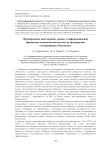
Статья научная
The construction of detailed accounting that allows to generate complex analytical reporting is an in-dispensable requirement of a modern financial system. For enterprises of the State Space Corporation “Roskosmos” with custom-made and small-scale production, operating in the conditions of Federal Law No. 275, characterized by a large amount of R&D and a high degree of uncertainty in the process of creat-ing products, this task is a system-forming one. The reporting should contain consistent data in any area of management and accounting at any given time. Along with this, system must provide the flexibility, reliabil-ity and performance inherent in transactional databases. To build information support that satisfies the specified conditions, it is required either to separate OLTP and OLAP data schemes, or to apply special-ized solutions based on the use of structures and techniques optimized for performing OLAP operations in traditional RDBMSs. This article considers the approach to form the multidimensional data in an automat-ed management system for economic tasks, as an effective alternative to complex and expensive BI solu-tions. Unlike many commercial systems, the ASU FEZ does not store redundant data (for example, opera-tional accounting registers in the 1C: Enterprise platform) required to build analytical accounting. The underlying data structures and methods of their processing allow for all types of accounting and have pow-erful tools for constructing analytical reporting. The article proposes algorithms for the operation of the system using the example of building simple OLAP cubes used in real tasks of automating financial and economic activities in ISS JSC for one of the Purchase subsystems. The formalization of these problems is carried out, the mathematical apparatus for constructing multidimensional data models based on infor-mation from a fixed set of normalized tables of a relational database is considered.The examples of SQL queries and outputs are provided. The advantages of using the system in operational management and accounting at the enterprise increasing its operational efficiency are summarized.
Бесплатно
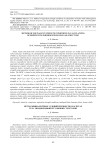
Статья научная
Plates, beams and shells with a non-uniform and micro-uniform regular structure are widely used in aviation and rocket and space technology. In calculating the strength of elastic composite structures using the finite element method (FEM) it is important to know the error of the approximate solution for finding where you need to build a sequence of approximate solutions that is connected with the procedure of crushing discrete models. Implementation of the procedure for grinding (within the micro-pass) discrete models of composite structures (bodies) requires large computer resources, especially for discrete models with a microinhomogeneous structure. In this paper, we propose a method of equivalent strength conditions (MESC) for calculating elastic bodies static strength with inhomogeneous and microinhomogeneous regular structures, which is implemented via FEM using multigrid finite elements. The calculation of composite bodies’ strength according to MESC is limited to the calculation of elastic isotropic homogeneous bodies strength using equivalent strength conditions, which are determined based on the strength conditions set for composite bodies. The MESC is based on the following statement. For all composite bodies V0 , which are such a homogeneous isotropic body V b and the number of p , if the safety factor nb of the body Vb satisfies the equivalent conditions of strength 2 pn1(1 ) nb (1 ) pn2 (1 ) , the safety factor n0 of the body V0 meets the defined criteria for strength n1 n0 n2 , where n1 , n2 specified, the safety factor n0 ( nb ) complies with the accurate (approximate) solution of elasticity theory problem is built for body V0 (body Vb ); (n2 n1) / (n2 n1) ; is the upper b error estimation of the maximum equivalent body stress V b , corresponding to approximate solution. When constructing equivalent strength conditions, i. e when finding the equivalence p coefficient, a system of discrete models is used, dimensions of which are smaller than the dimensions of the basic composite bodies models. The implementation of MESC requires small computer resources and does not use procedures for grinding composite discrete models. Strength calculations for bodies with a microinhomogeneous structure using MESC show its high efficiency. The main procedures for implementing the MESC are briefly described.
Бесплатно
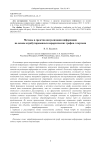
Статья научная
At present visualization of graph models is an inherent part of the processing of complex information about the structure of objects, systems and processes in many applications in science and technology, and at the market there are widely presented science-intensive software products, using the information visualization on the basis of graph models. Since the information to visualize is constantly growing and becoming more complex, more and more situations are arising, where classical graph models cease to be adequate. More powerful graph-theoretic formalisms are required and appear to represent information models with a hierarchical structure, since hierarchy is the basis of numerous methods for visual processing of complex big data in various fields of application. One of these formalisms is the so-called hierarchical graphs. This formalism allows to select a set of such its parts (so-called fragments) in the given classical graph that all elements of each selected fragment deserve a separate joint consideration, and all fragments of the selected set form a nesting hierarchy. At the A. P. Ershov Institute of Informatics Systems, the Visual Graph visualization system was constructed, which is based on hierarchical graphs and allows to explore complex structured big data through their visual representations. In many applications, objects modeled by graph vertices are complex and contain non-intersecting logical parts (so-called ports) through which these objects are in a relationship modeled by arcs. In the paper, the formalism of attributed hierarchical graphs with ports is introduced and new possibilities of the Visual Graph system for visualization of large structured data based on attributed hierarchical graphs with ports are considered.
Бесплатно
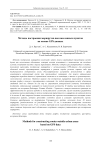
Methods for constructing routes outside urban areas based on GPS data
Статья научная
Route constructing methods include the task of finding the shortest trajectory between two or more ob-jects, which may vary depending on weather conditions, altitude coordinates, and other parameters. The methods discussed in the article allow constructing routes using GPS tracks for various fields of knowledge: designing routes within a city, region, country, or with remote sensing of the earth. The consid-ered algorithms are used in the field of environmental monitoring in emergency situations, to search for optimal data transmission routes in satellite systems and their validation, as well as in organizational and economic systems. The most widely used approaches for constructing routes are graph theory and search in the state space, where any trajectory between objects is given its own weight. However, there is still no system that allows to make a tourist route over rough terrain. The article discusses such methods as the Dijkstra, Levit, Floyd-Warshell algorithm, and it also compares their effectiveness in terms of running time and complexity. The aim of the work is to develop an algorithm for finding the shortest path and building a tourist route from a given point A to point B. This development will open up new opportunities for citizens to independently visit new interesting areas, actively spend their free time and get to know the surroundings of the city. The system has been tested on the territory of the Torgashinsky ridge, includes more than 38 route points located at a distance of more than 25 kilometers, and allows to build the desired routes within less than 15 milliseconds. At the same time, the system enters person’s coordinates, which are considered when constructing routes.
Бесплатно
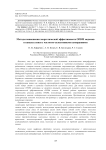
Статья научная
It is a fact that during data transmission, inter-symbol interference can occur, caused by the presence of multipath propagation and frequency-selective fading in the radio channel, which can significantly reduce the energy efficiency of communication systems. One of the methods to combat such effects, relevant today, is the use of OFDM modulation (OFDM – Orthogonal Frequency Division Multiplexing), which allows to flexibly change the data rate, reduce the frequency resource by improving the spectral efficiency, and also deal with frequency – selective fading and selective interference. However, there are channels that are particularly susceptible to inter-symbol interference, such as, for example, the tropospheric channel. Also, the problem of selective interference is particularly acute in near-field magnetic induction communication systems. For such channels, the use of OFDM modulation itself is not a panacea; the task of increasing the energy efficiency of an OFDM signal is an urgent one. This paper presents the key features of the OFDM mode of operation, which make it possible to increase the energy potential of the radio link in channels subject to intersymbol distortion. The results of modeling methods for PAPR reduction and digital predistortion for the linearization of the transmission path are presented. The practical significance of the work lies in the fact that the use of transmission path linearization methods will increase the maximum bandwidth of communication systems, primarily those using tropo-spheric, radio relay and near-field magnetic induction communication channels. At present, this issue is particularly acute, since there are no high-speed tropospheric stations with a data transfer rate of 50 Mbps in Russia. Increasing the throughput in tropospheric communication will provide communication to hard-to-reach settlements with difficult terrain. Also, the use of high-speed tropospheric communication is a cost-effective alternative to satellite communication, since its use does not require the lease of a satellite channel.
Бесплатно
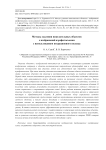
Methods of removing unwanted objects from aerial photography images using iterative approach
Статья научная
Removing objects from images refers both to the tasks of improving the quality of the image, for example, in the field of recovering damaged photographs, and the tasks of increasing safety when removing people or cars from aerial photography images with remote sensing of the earth. At the same time, methods for removing unwanted objects usually include two stages: selecting objects for removal and restoring texture in areas of the image. The first stage can be performed manually by users, if it is necessary to select specific objects, or automatically by training the model on different classes of objects. The problem of image restoration in the course of research was solved by various methods, the main one of which involves using of the values of neighboring pixels for rendering in distant areas. In recent years, methods using deep learning based on convolutional and generative neural networks have shown good results. The aim of the work is to develop a method for removing objects from aerial photography images with manually selecting objects and drawing textures in the processed area. The paper reviews modern methods of image restoration, among which the most promising are the use of deep learning networks, as well as texture analysis in the restored area. The proposed algorithm is based on an iterative approach when analyzing neighboring areas and gradually painting the restored area with a texture from neighboring pixels, taking into account the weight and contours of the boundaries. The article evaluates the effectiveness of the proposed method using the base of video sequences obtained from quadcopters and containing people and natural objects. At the same time, both an expert assessment was carried out, which showed good visual results, and a comparison of the quality of the algorithm with known approaches according to the PSNR metric, which showed the best results in the presence of a complex texture in the scene.
Бесплатно
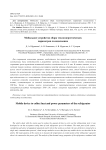
Mobile device to collect heat and power parameters of the refrigerator
Статья научная
The article deals with the system used to reduce the amount of time to carry out the refrigeration tests; it was developed to cut the acceptance testing time of each refrigerator up to 6-9 minutes. The main parts of the system , considering each piece of equipment separately and its role in the system as a whole, the way all devices connected to a single unit, communication protocol, cloud storage method to access data from any mobile device are described in the article. The main purpose of the system is to measure the temperature at certain points of the refrigerator capacitor when it is connected to the power grid. The analysis of the thermal energy properties of the refrigerator, combined with the analysis of the cooling speed of the refrigeration chambers (as well as the heating of the capacitor) makes it possible to understand whether each refrigerator corresponds to certain characteristics established by GOST. The article also presents the characteristics of the devices being used (temperature meter-regulator TRM 138, the ME110-224-1M electrical network measurement module).
Бесплатно

Статья научная
The problem of weightlessness simulation of beam systems suspended on inextensible cables is considered. Imitation of weightlessness means zeroing or reducing any selected force factor (for example, the reaction of the support or the moment in the support or joint), and the kinematic factor (deflection or angle of rotation). It is required to select the forces in the cables such that the sum of the squares of the deflections at the points of the elastic line of the beam is minimal. The problem is formulated as a nonlinear programming problem; the search for the minimum of the objective function with constraints, in the form of equilibrium equations, is carried out. In general, all equations written out for a geometrically variable system are linearly dependent. Parameters are selected from the system of equations, the vectors at which are entered into the basis, and the remaining parameters are considered free and are the coordinates of the objective function. The problem was reduced to the problem of quadratic programming without restrictions. Partial derivatives of coordinates give a system of linear algebraic equations that allows you to determine the coordinates taken as free parameters, and then calculate the coordinates entered into the basis. The reference plan of nonlinear optimization problems can have local minima; it is shown that for any initial basis, the optimal plan is the only one. To calculate the deflections of the beam, the method of initial parameters is used. Deflection, angle of rotation, additional angles of rotation in articulated joints are considered as initial parameters; as well as the reaction and bending moment. The continuum problem is transformed into a discrete one by limiting the number of points at which deflections are calculated. The objective function has a finite number of variables. It is determined which number of selected points on the elastic line of the beams is sufficient to ensure the convergence of the functions of deflections, angles of rotation, bending moments and transverse forces for the purpose of application to practical calculations. Optimization of deflections of a beam pivotally fixed, suspended on two cables with verification of solutions, change of basic variables and convergence study depending on the choice of the number of points at which deflections are calculated is performed. The deformation of systems of I-beams connected by hinges to each other, having linear weight in gravity conditions, is analyzed. To simulate weightlessness, the system is supported by six cables. The boundary conditions are considered: – rigid pinching; – hinge-fixed support, – sliding sealing; – free edge. Models of three-beam systems in the simulation of weightlessness, to a certain extent equivalent. The type of boundary condition affects the first beam to a greater extent; the tension forces of the cables equalize the deformed and stressed state in subsequent beams. Any of the considered systems with the presented boundary conditions can be converted into an equivalent one by changing the boundary force factors, setting torques or installing a spring with a given stiffness and adjusting the tension of the cables.
Бесплатно
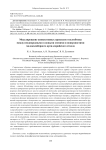
Статья научная
The current models of aviation artillery weapons (AAW) are the pulsed heat engines that convert the energy of a powder charge into the energy of highly compressed and heated powder gases (hereinafter referred to as gases), which, when expanding, perform work on communicating kinetic energy to the projectile. In the context of artillery science, aviation artillery weapons and ammunition are structured as a system that interacts with heat sources and the environment, sequentially completing thermodynamic cycles. The main element that is most intensively subjected to thermophysical loads and has a significant impact on the combat qualities and cost of aviation artillery weapons is a small-caliber artillery barrel (hereinafter referred to as the barrel). As a result, the problem of determining the temperature field of the barrel is one of the central problems of designing aviation artillery weapons and optimizing firing modes. The successful solution of this problem largely depends on the accuracy of modeling the processes of heat transfer to the channel and from the outer wall of the barrel during firing. At the same time, an adequate synthesis and calculation of the relations describing the phenomenon of convection accompanying the shot is difficult, which is due to the presence of phase transformations in the state of gases; the simultaneous presence of supersonic and subsonic zones in the solution regions; the existence of laminar, turbulent flows and other non-linear formations. The aim of the work is to develop a relatively simple and acceptable for engineering practice mathematical model of heat transfer inside and around the barrel with near-wall coolant flows (hereinafter referred to as the model). Achieving the goal of the work is carried out by a concentrated choice of criterion equations of the apparatus of thermodynamic similarity, corresponding to the geometric and physical conditions for the uniqueness of the processes of loading the barrel. The introduction of functions that take into account the dependence of the thermophysical properties of gases on temperature made it possible to increase the accuracy of determining the parameters of heat transfer during a shot by 19% in comparison with the known results. The developed model can be used in applied calculations related to determining the thermal state of the barrel. The specialization of the object of study does not exclude the possibility of refining the model for the purpose of mathematical representation of thermal effects in thermally stressed structures of complex shape.
Бесплатно
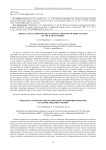
Models and algorithms for automatic grouping of objects based on the k-means model
Статья научная
The paper is devoted to the study and development of new algorithms for automatic grouping of objects. The algorithms can improve the accuracy and stability of the result of solving practical problems, such as the problems of identifying homogeneous batches of industrial products. The paper examines the application of the k-means algorithm with the Euclidean, Manhattan, Mahalanobis distance measures for the problem of automatic grouping of objects with a large number of parameters. A new model is presented for solving problems of automatic grouping of industrial products based on the k-means model with the Mahalanobis distance measure. The model uses a training procedure by calculating the averaged estimate of the covariance matrix for the training sample (sample with pre-labeled data). A new algorithm for automatic grouping of objects based on an optimization model of k-means with the Mahalanobis distance measure and a weighted average covariance matrix calculated from a training sample is proposed. The algorithm allows reducing the proportion of errors (increasing the Rand index) when identifying homogeneous production batches of products based on the results of tests. A new approach to the development of genetic algorithms for the k-means problem with the use of a single greedy agglomerative heuristic procedure as the crossover operator and the mutation operator is presented. The computational experiment has shown that the new mutation procedure is fast and efficient in comparison with the original mutation of the genetic algorithm. The high rate of convergence of the objective function is shown. The use of this algorithm allows a statistically significant increase both in the accuracy of the result (improving the achieved value of the objective function within the framework of the chosen mathematical model for solving the problem of automatic grouping), and in its stability, in a fixed time, in comparison with the known algorithms of automatic grouping. The results show that the idea of including a new mutation operator in the genetic algorithm significantly improves the results of the simplest genetic algorithm for the k-means problem.
Бесплатно

Статья научная
The article discusses formalization of the problem of heterogeneous distributed information processing systems (HDIPS) software and hardware configuration management. A formal description of possible optimality criteria for the HDIPS software and hardware configuration is given. The HDIPS model in terms of queuing theory is proposed. The problem of allocating the HDIPS computational resources is formulated as a transport problem according to time criterion with atomic needs. The algorithm for solving this problem is proposed and the boundaries of its applicability to the HDIPS are determined. To meet the selected optimality criterion, the analysis of the HDIPS software and hardware configuration applying its formal model, using the queuing theory methods is presented. HDIPS is presented as a queuing network, where each computing node and route control unit is a mass service system. The problem of computing resource allocation in HDIPS is presented as a transport problem according to the time criterion with atomic needs. The least time algorithm for indivisible needs takes into account the indivisibility condition.
Бесплатно
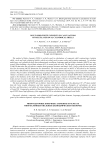
Multi-grid finite elements in calculations of multilayer oval cylindrical shells
Статья научная
The method of finite elements (FEM) is actively used in calculations of composite shell constructions (rotation shells, circle and oval cylindrical shells), which are widely used in space-rocket and aviation equipment. To calculate multi-layer oval cylindrical shells three-dimensional curvilinear Lagrange multi-grid finite elements (MGFE) are suggested. When building a k-grid finite element (FE), k nested grids are used. The fine grid is generated by the basic split of MGFE that takes into account its complex heterogeneous structure and shape. On k-1 large grids the move functions used for decreasing MGFE dimension are determined. The stress-strain state in MGFE is described by the elasticity theory three-dimensional task equations (without introduction of additional hypotheses) in local Cartesian coordinates systems. The procedure of building shell-type Lagrange MGFE with the use of Lagrange polynomials presented in curvilinear coordinate systems is demonstrated. With the size reduction of discrete models MGFE have constant thickness equal to the thickness of the shell. The Lagrange polynomials nodes coincide in thickness with the MGFE large grid nodes and are located on the shared borders of different module layers. The use of such MGFE generates approximate solutions sequences that uniformly and quickly converge to precise solutions. The main advantages of MGFE are as follows: they form discrete models with the dimension 102–106 times smaller than the basic models dimension and they generate small error solutions. Examples of calculations are given for four- and three-layer oval shells of various thickness and shape under both uniform and local loading with the use of 3-grid FE. Comparative analysis of the obtained solutions with the solutions built with the help of the software package ANSYS shows high efficiency of the suggested MGFE in calculations of multi-grid oval shells.
Бесплатно
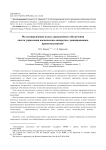
Multiversion model of software control systems for space vehicles with range of decision-making
Статья научная
The paper presents a multi-version model with ranking of alternatives in order of preference, taking into account the dependence of the attributes in the design of software for spacecraft control systems of various classes. The applied software with a set of algorithms, based on the general scheme of the method of branches and borders allow determining the exact solution of the optimization problem. To achieve the highest reliability of the software component of spacecraft control systems built with the use of multi-version programming methodology, a large number of versions of software modules are combined into a single structure. While software complexes even without introduction of redundant elements are characterized as complex systems, there is no need to speak about wide use of enumerative methods for their formation. Using the proposed modified method of ordered preference through similarity to an ideal solution, will allow to solve the problem of choosing the best computing system from a number of available systems. This approach is becoming increasingly possible because of the tremendous progress in computing design and manufacturing technology. Even the so-called personal computers provide computational capabilities that some time ago seemed impossible even for computers representing a much more powerful class of computing equipment - supercomputers.
Бесплатно
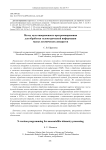
N-version programming for nanosatellite telemetry processing
Статья научная
Software is a key element that ensures the functioning of any modern complex technical system. One such system is the constellation of spacecraft and associated ground control complexes that provide reception, transmission, and processing of collected telemetry. The process of data acquisition and its subsequent processing is critical to the flight control of the spacecraft and its onboard scientific equipment. Furthermore, telemetry data processed by ground control systems involves large volumes of raw data, the processing of which is a complicated and time-consuming task. In order to solve this problem, various methods of automatic data processing are used. Improving them is a key factor in ensuring the fault tolerance of onboard software and hardware, improving its reliability. Of all the existing widely-used methods of data processing, we shall focus on N-version programming (NVP) approach. N-version programming has firmly established itself as an effective method for increasing software reliability and designing fault-tolerant systems. Since its inception in the 1970s, this approach has been deeply connected with the development of aerospace software systems, including, among others, satellite ground control stations. In light of the aforementioned, this paper discusses the application of NVP for processing telemetry data gathered from nanosatellites (CubeSats). Due to the fact that there exists a skeptical view on the NVP approach in terms of its efficiency, the author covers this issue in existing literature in terms of the approach’s applicability for processing satellite telemetry.
Бесплатно
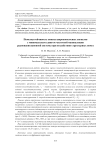
Статья научная
In the presented work, an assessment of the noise immunity of the parallel algorithm of the broadband signals with frequency manipulation with minimal shift time search is given. The threshold value of the Signal-to-Noise ratio per one L signal is used as a criterion, which ensures the required accuracy of code synchronization with a given error probability. In this case, the task of temporary search is formed as a task of L signals recognition which modulating code sequences { } kl d differ by a time cyclic shift τk (k 1) τэ (k 1,L,L the length of the modulating code sequence, э the duration of the signal element or the element of the modulating code sequence) equal to energy. The L -dimensional probability density of the modules 1,..., LVV ( i V the correlation module of the analyzed and comparison signals at the output of the quadrature correlator) is preliminarily determined. The probability of error is determined by L -multiple integration of the L -dimensional probability density of modules 1,..., L VV. The problem of determining the energy losses in the analyzed signal under the influence of structural interference is solved. In this case, a quadrature recognition circuit of one of two discrete signals is used and the Signal-to- Noise ratio at the output of the recognition circuit is determined, taking into account the effect of structural interference, and a comparison is made with the Signal-to-Noise ratio for the analyzed signal acting at the input of the quadrature recognition circuit. An assessment of the structural interference impact on the temporary search is given, taking into account the normalized periodic autocorrelation function (NPACF) of the analyzed signal and structural interference (at L 16383). It is shown that it is most rational to work with NPACF in its ascending section (cycle interval [ 361τ , 540τ э э]), while the reciprocal correlation coefficient will not exceed 4 · 10–3 and the equivalent energy losses of the analyzed signal will not exceed 3 dB. At an intensity of 34 dB of structural interference, the use of an ascending section of the NPACF allows minimizing the energy losses of the analyzed signal and temporary searching for a time of 0.35 s (at τэ = 2.5 microseconds).
Бесплатно
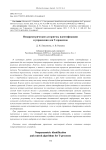
Non-parametric identification and control algorithms for T-processes
Статья научная
In this paper, nonparametric identification and control methods are considered for multidimensional discrete-continuous processes with a delay inherent in many real productions. Such systems are typical for practice, including in the rocket and space industry, as well as in the technological processes of space technology production. Considering multidimensional processes, it is necessary to take into account the relationships between input and output variables, as well as their relationships with each other. Moreover, these connections are not always known to the researcher. When taking into account unknown connections of input variables, the researcher will deal with tubular processes or H-models, and when taking into account unknown connections of output variables, the model for one or another channel of the object will be analogs of implicit functions. In general, the model of a multidimensional object will be represented as a system of nonlinear implicit equations. In this case, the solution of the identification problem will be reduced to finding the prediction of the vector of output variables from the known values of the vector of input variables and can be obtained only as a result of solving the corresponding system of equations, which were called T-models. The solution of a system of nonlinear implicit equations by parametric identification methods will not lead to the desired result due to the lack of sufficient a priori information, and here there is a need for the use of nonparametric identification methods, as well as the use of system analysis methods. A priori information in the tasks of nonparametric statistics is insufficient, which conventional identification methods cannot cope with. When controlling multidimensional processes, it is necessary to take into account the dependencies of output variables, in connection with which another important feature arises, namely: random values from the domain of determining output variables cannot be used as setting influences; they must be selected from their common intersection.
Бесплатно
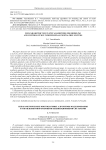
Статья научная
The paper discusses new classes of models of multidimensional inertia-free systems with a delay in the condi-tions of a lack of a priori information. The subject is multidimensional discrete-continuous processes, the com-ponents of the vector of output variables of which are stochastically dependent in an unknown way. There are also processes, through some channels of which aprior information corresponds simultaneously to both the par-ametric and nonparametric type of source data about the studied process. The mathematical description of such processes leads to a system of implicit nonlinear equations, some of which will be unknown, while others will be known with accuracy to the parameter vector. The main purpose of a model of an object having stochastic de-pendencies of output variables is to find a forecast of output variables with known input variables. To find the predicted values of the output variables from known inputs, it is necessary to solve a system of im-plicit nonlinear equations. The problem is to solve a system that is actually unknown, when only equations for some channels of a multidimensional system are known. Thus, a rather nontrivial situation arises when solving a system of implicit nonlinear equations under conditions when, in one channel of a multidimensional system, the equations themselves are not in the usual sense, and in others they are known accurate to parameters. Therefore, an object model cannot be constructed using the methods of the existing identification theory because of a lack of aprior information. The purpose of this work is the solution of the identification problem in the presence of a partially-parameterized discrete-continuous process, and despite the fact that the parameterization stage cannot be overcome without additional priori information about the process under study. The control algorithm for multidimensional processes with dependencies of output variables is a sequential multi-step algorithmic chain that allows finding the control action and bring the object to the desired state. Computational experiments to study the proposed models and to control multidimensional discrete-continuous processes have shown quite satisfactory results. The article presents the results of computational experiments illustrating the effectiveness of the proposed technology for predicting the values of output varia-bles from known input variables, as well as for managing these processes.
Бесплатно

